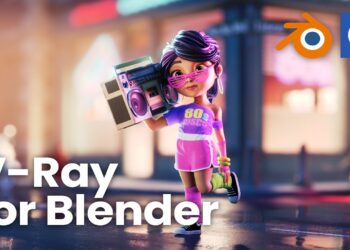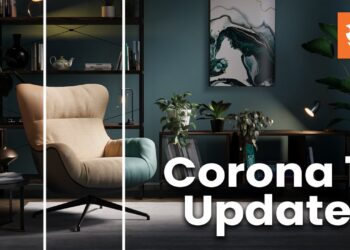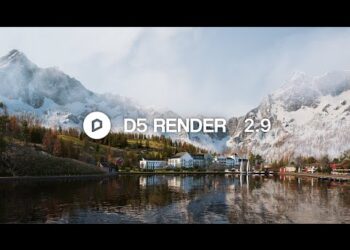The team at Fabric Engine has released three videos demonstrating the latest developments of their real-time renderer in 3DS Max. Fabric Engine’s RTR is an interactive viewport renderer that incorporates high-end game engine rendering technology, allowing to use several orders of magnitude more geometry and lights, as well as handling post-effects and HDR lighting.
Per pixel projection example video – shows RTR being used for building targeted tools for production. This is a camera projection tool that Fabric put together with a Max studio, and that they’ll be making available as part of Fabric Engine soon.
Scene assembly and scalability video – a look at scene assembly in Max using the Fabric RTR rendering to the Max viewport.
Scene assembly and DoF – shows the stochastic depth of field capability of the RTR to produce reliable previews.
More information can be found on the Creation discussion list and Fabric Engine’s website.









That’s incredible!! Fabric Engine is developing some amazing new tech.
very usefull for big projects
I’ve put the videos up on our Max RTR page now: http://fabricengine.com/creation/3dsmax-rtr/
It’s important to understand that Fabric Engine is a platform, not a shrink-wrapped application or plugin. You need to be able to write Python in order to use it – it’s targeted at TDs/programmers that are building tools for production teams.
If you’d like to get on our testing group and follow our mailing list, you can sign up here: http://fabricengine.com/get-creation/
Please note that this is an early look at what we’re doing in Max i.e. it’s not available in the current build.
Thanks for your time,
Paul
Thanks for all your efforts FabricEngine, It’s really nice to see at least 3rd party groups are developing these kind of pipeline platforms for Max, just out of curiosity is the whole Python programing aspect related to the recent implementation of Python in Max or would it still be possible without that and also does the presence of Python in Max affect working with this tool in any way?..
@Paul: But will you include the Max integration or is it just an experimental demo of what’s possible?
@rs – we will make it available initially to studios that contact us directly (we have a few using it/playing with it now) and then as it stabilizes we’ll make it available as part of the framework. The camera projection tool is a bit more specialised, so I’m not sure if/when that will be made generally available
@DAngel – there’s no dependency on the Python implementation in Max. Python is how we build standalone applications for Fabric, along with KL(Kernel Language) as the language for writing high-performance code. Pretty much the entire renderer is written in KL. You can learn more about KL here: http://fabricengine.com/splice/kernel-language-kl/
I’ll be posting a new video on the RTR later today (a general overview of it, not specific to Max). I’ll share the link here.
Cheers,
Paul
This nitrous but WORKING 😀
Man, I want multi pass effects back so bad since max2011.
But does it support vertex color maps? i gathered it supports changing topology but what about particles?
Who cares about DOF or shadows in the viewport. Game engines have had this tech for years. In a monster scene file with Animation and heavy fx’s let’s see something realtime. Something with big point caches files, TP caches, deforming meshes etc..
I agree about the DOF and shadows. This engine is not catered to us fx folks though, i think 🙂 I just miss bing able to make previews with MBlur. It sometimes sells the shot so much better, especially for particles/TP fragmentation, etc.
The Fabric RTR is used for shot preview in major VFX studios, so a lot of people actually do care about having these effects in the viiewport. In some cases they absolutely require DoF, motion blur, soft shadows etc for their work. Most importantly, they need it to be a reliable representation of the offline result (e.g. stochastic sampling, no screenspace effects etc).
The problem with (most) game engines is that they are one-way pipelines to a runtime target, destructive to data and provide no easy path back out again. The Fabric RTR is designed to work with Alembic, FBX, custom data types etc There is some information here: http://fabricengine.com/creation/rendering/ – it’s a bit out of date (we’re working on the update) but it should help you understand what it is and what it’s for. It’s absolutely designed for VFX.
The camera projection tool shown is for a major VFX studio, but unfortunately I cannot tell you who it is.
I don’t understand it well, what is the difference with Nitrous besides that Nitrous is written by AutoDesk and is probably flawed.
The Fabric RTR is _not_ meant to be a replacement viewport – it’s really for building custom applications like the projection mapping tool. Fabric Engine itself is a platform for building 2D and 3D applications, the RTR is a part of the platform that can be used for many different requirements. It’s a completely customizable openGL renderer – as per my earlier comment, you can find out more here: http://fabricengine.com/creation/rendering/
As mentioned in an earlier comment, here’s a couple of videos that cover the new stochastic DoF and Motion Blur:
Teaser – https://vimeo.com/74730770
Tech Overview – https://vimeo.com/74731821
As for the types of things possible with the real-time renderer, you might want to look at the Horde crowd/previz application we showed at Real-Time Live at Siggraph this year: https://vimeo.com/70806012 – it’s a good example as it shows the amount of geometry/complexity that Fabric can handle, but also shows how it can be integrated to a host application.